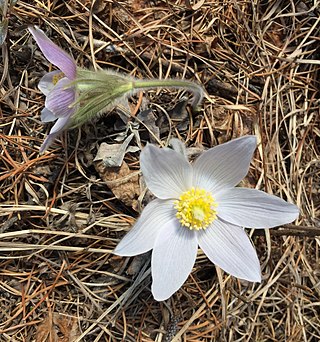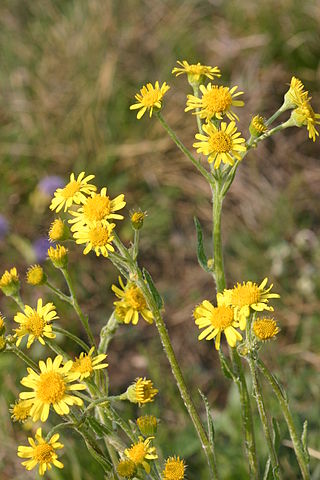
The genus Pulsatilla contains about 40 species of herbaceous perennial plants native to meadows and prairies of North America, Europe, and Asia. Derived from the Hebrew word for Passover, "pasakh", the common name pasque flower refers to the Easter (Passover) flowering period, in the spring. Common names include pasque flower, wind flower, prairie crocus, Easter flower, and meadow anemone. Several species are valued ornamentals because of their finely-dissected leaves, solitary bell-shaped flowers, and plumed seed heads. The showy part of the flower consists of sepals, not petals.

Pulsatilla vulgaris, the pasqueflower, is a species of flowering plant belonging to the buttercup family (Ranunculaceae), found locally on calcareous grassland in Europe, and widely cultivated in gardens. It was considered part of the genus Anemone, to which it is closely related. Several sources still list Anemone pulsatilla as the accepted name, with Pulsatilla vulgaris as a synonym.

Pulsatilla alpina, the alpine pasqueflower or alpine anemone, is a species of flowering plant in the family Ranunculaceae, native to the mountain ranges of central and southern Europe, from central Spain to Croatia. It is an herbaceous perennial growing to 15–30 cm (6–12 in) tall by 20 cm (8 in) wide, and can be found at altitudes of 1,200–2,700 m (3,900–8,900 ft).

Banksia integrifolia, commonly known as the coast banksia, is a species of tree that grows along the east coast of Australia. One of the most widely distributed Banksia species, it occurs between Victoria and Central Queensland in a broad range of habitats, from coastal dunes to mountains. It is highly variable in form, but is most often encountered as a tree up to 25 metres (82 ft) in height. Its leaves have dark green upper surfaces and white undersides, a contrast that can be striking on windy days.

Pulsatilla pratensis, the small pasque flower, is a species of flowering plant in the family Ranunculaceae, native to central and eastern Europe, from southeast Norway and western Denmark south and east to Bulgaria. It grows from near sea level in the north of the range, up to 2,100 m (6,900 ft) in the south of its range.

The taxonomy of Banksia integrifolia has a long and complex history, the result of confusion caused by the species' great variability, and similarities with some closely related species. The existence of hybrids between B. integrifolia and related species as well as early attempts to classify the species based on dried specimen material have also contributed to the confusion.

Banksia integrifolia subsp. integrifolia is a subspecies of Banksia integrifolia.

Banksia integrifolia subsp. compar is a subspecies of Banksia integrifolia. It has larger, glossier leaves than other subspecies, and occurs much further north.

Banksia integrifolia subsp. monticola, commonly known as White Mountain banksia, is a subspecies of Banksia integrifolia. Described in 1994, it occurs in the Blue Mountains and in northern New South Wales. It contains the largest recorded Banksia trees.

Pulsatilla patens is a species of flowering plant in the family Ranunculaceae, native to Europe, Russia, Mongolia, and China. Common names include Eastern pasqueflower and cutleaf anemone.

Macadamia integrifolia is a small to medium-sized tree, growing to 15 metres in height. Native to rainforests in south east Queensland and northern New South Wales, Australia. Common names include macadamia, smooth-shelled macadamia, bush nut, Queensland nut, Bauple nut and nut oak.
Pulsatilla chinensis is a species of plant in the family Ranunculaceae and is one of the 50 fundamental herbs used in traditional Chinese medicine. There it has the name bái tóu wēng.
Ülle Kukk is an Estonian botanist and conservationist.

Pulsatilla koreana, the Korean pasque flower, is one species of the genus Pulsatilla. P. koreana is a hairy, tufted, perennial herb. It is a native perennial plant growing in Korea and used as a traditional Korean herbal medicine.

Pulsatilla nuttalliana, known as American pasqueflower, prairie pasqueflower, prairie crocus, or simply pasqueflower, is a flowering plant native to much of North America, from the western side of Lake Michigan, to northern Canada in the Northwest Territories, south to New Mexico in the southwestern United States. Pasqueflower is the provincial flower of Manitoba and the state flower of South Dakota.

Pulsatilla grandis, the greater pasque flower, is a species of flowering plant in the genus Pulsatilla of the family Ranunculaceae. It is a perennial plant that grows on calcium-rich soil in dry grasslands, in rocky outcrops, and in pine and oak forests. It flowers from February to April, in the time of the Easter, with intensively blue to violet flowers. Its silk stalk is protected from the cold by velvety trichomes (hairs). Pulsatilla grandis is native to the countries of Central, Eastern and Southeastern Europe, and is particularly frequent in Hungary. In some of them, it is classed as threatened.

Petunia integrifolia, the violet petunia or violetflower petunia, is a species of wild petunia with violet-colored blooms. Petunia integrifolia is native to Argentina. P. integrifolia bears flowers approximately 1.5 inch in diameter and the plant is typically smaller and harder to cultivate than the well-known hybrid bedding Petunia now known correctly as Petunia × atkinsiana.

Zamia integrifolia, also known as coontie palm is a small, tough, woody cycad native to the southeastern United States, the Bahamas, Cuba, and the Cayman Islands.

Pulsatilla cernua, the narrow-leaf pasque-flower is a species of plant in the family Ranunculaceae Pulsatilla cernua is a perennial plant that can grow to be about 0.2 m or 8 in tall. This plant has six dark red/purple flowers and has tiny white, silky villose hairs. Pulsatilla cernua flowers from April to May, and then the seeds ripen from May to June. P. cernua is insect pollinated. This plant has both male and female parts, which means it is a hermaphrodite. Most parts of this plant are not edible, except for the roots and leaves.

Tephroseris integrifolia is a species of flowering plant belonging to the family Asteraceae.














